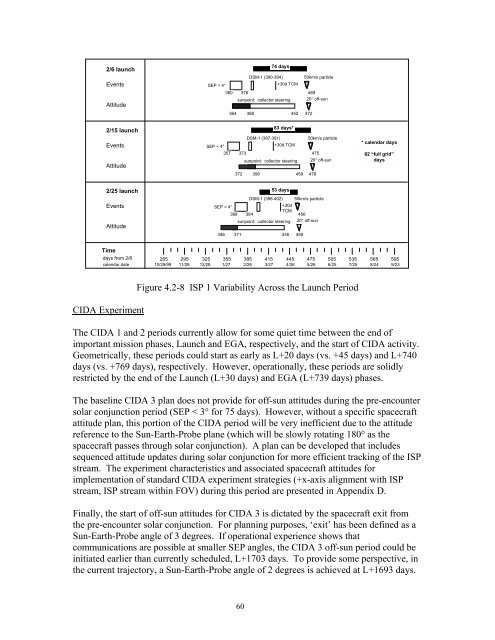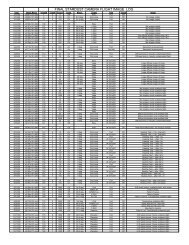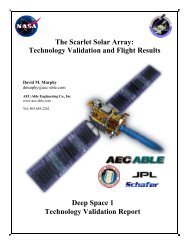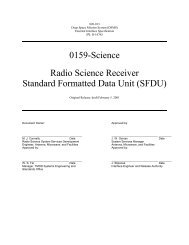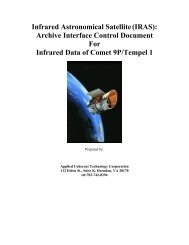MISSION PLAN - PDS Small Bodies Node
MISSION PLAN - PDS Small Bodies Node
MISSION PLAN - PDS Small Bodies Node
Create successful ePaper yourself
Turn your PDF publications into a flip-book with our unique Google optimized e-Paper software.
2/6 launch<br />
Events<br />
Attitude<br />
74 days<br />
DSM-1 (390-394)<br />
SEP < 4°<br />
+30d TCM<br />
360 376<br />
sunpoint: collector steering<br />
364 388<br />
452<br />
50km/s particle<br />
469<br />
20° off-sun<br />
472<br />
2/15 launch<br />
83 days*<br />
Events<br />
Attitude<br />
SEP < 4°<br />
357<br />
DSM-1 (387-391)<br />
+30d TCM<br />
373<br />
sunpoint: collector steering<br />
372 396<br />
459<br />
50km/s particle<br />
475<br />
20° off-sun<br />
478<br />
* calendar days<br />
82 “full grid”<br />
days<br />
2/25 launch<br />
Events<br />
Attitude<br />
SEP < 4°<br />
346<br />
368<br />
DSM-1 (398-402)<br />
384<br />
+30d<br />
TCM<br />
sunpoint: collector steering<br />
371<br />
53 days<br />
438<br />
50km/s particle<br />
456<br />
20° off-sun<br />
459<br />
Time<br />
days from 2/6<br />
265 295 325 355 385 415 445 475 505 535 565 595<br />
calendar date 10/29/99 11/28 12/28 1/27 2/26 3/27 4/26 5/26 6/25 7/25 8/24 9/23<br />
CIDA Experiment<br />
Figure 4.2-8 ISP 1 Variability Across the Launch Period<br />
The CIDA 1 and 2 periods currently allow for some quiet time between the end of<br />
important mission phases, Launch and EGA, respectively, and the start of CIDA activity.<br />
Geometrically, these periods could start as early as L+20 days (vs. +45 days) and L+740<br />
days (vs. +769 days), respectively. However, operationally, these periods are solidly<br />
restricted by the end of the Launch (L+30 days) and EGA (L+739 days) phases.<br />
The baseline CIDA 3 plan does not provide for off-sun attitudes during the pre-encounter<br />
solar conjunction period (SEP < 3° for 75 days). However, without a specific spacecraft<br />
attitude plan, this portion of the CIDA period will be very inefficient due to the attitude<br />
reference to the Sun-Earth-Probe plane (which will be slowly rotating 180° as the<br />
spacecraft passes through solar conjunction). A plan can be developed that includes<br />
sequenced attitude updates during solar conjunction for more efficient tracking of the ISP<br />
stream. The experiment characteristics and associated spacecraft attitudes for<br />
implementation of standard CIDA experiment strategies (+x-axis alignment with ISP<br />
stream, ISP stream within FOV) during this period are presented in Appendix D.<br />
Finally, the start of off-sun attitudes for CIDA 3 is dictated by the spacecraft exit from<br />
the pre-encounter solar conjunction. For planning purposes, ‘exit’ has been defined as a<br />
Sun-Earth-Probe angle of 3 degrees. If operational experience shows that<br />
communications are possible at smaller SEP angles, the CIDA 3 off-sun period could be<br />
initiated earlier than currently scheduled, L+1703 days. To provide some perspective, in<br />
the current trajectory, a Sun-Earth-Probe angle of 2 degrees is achieved at L+1693 days.<br />
60


